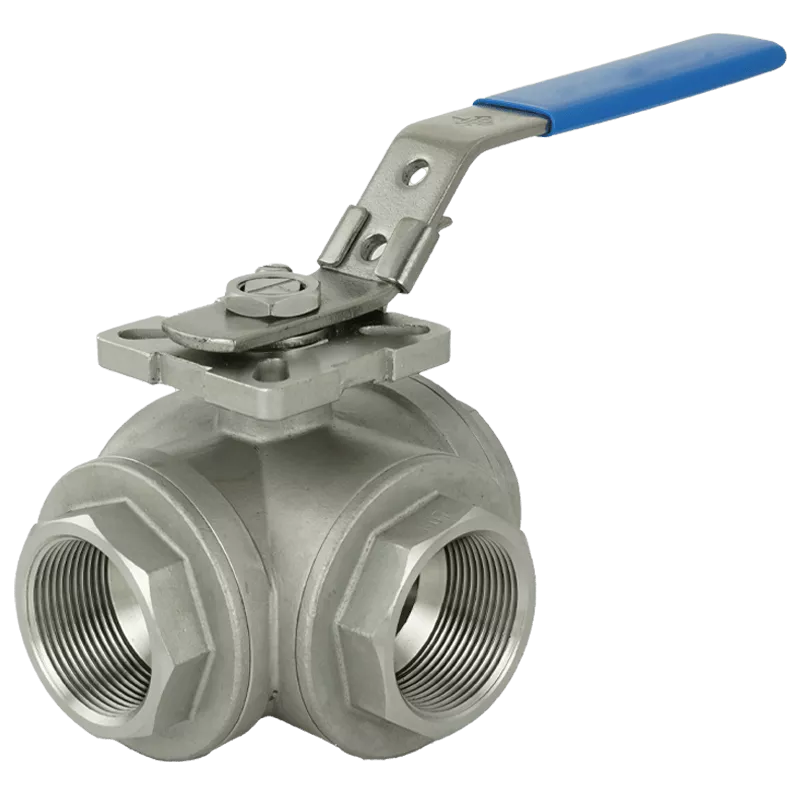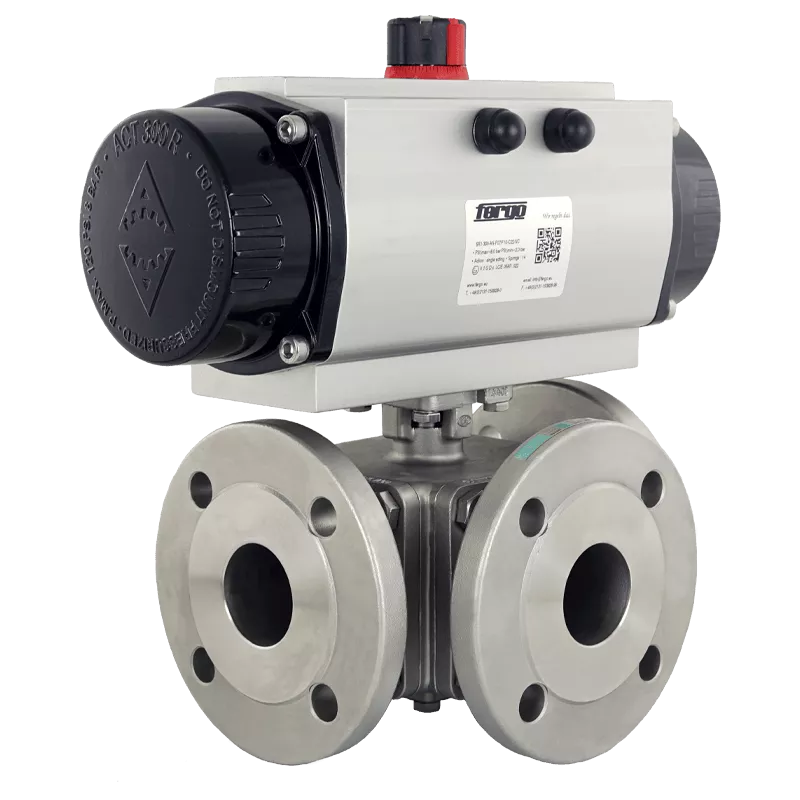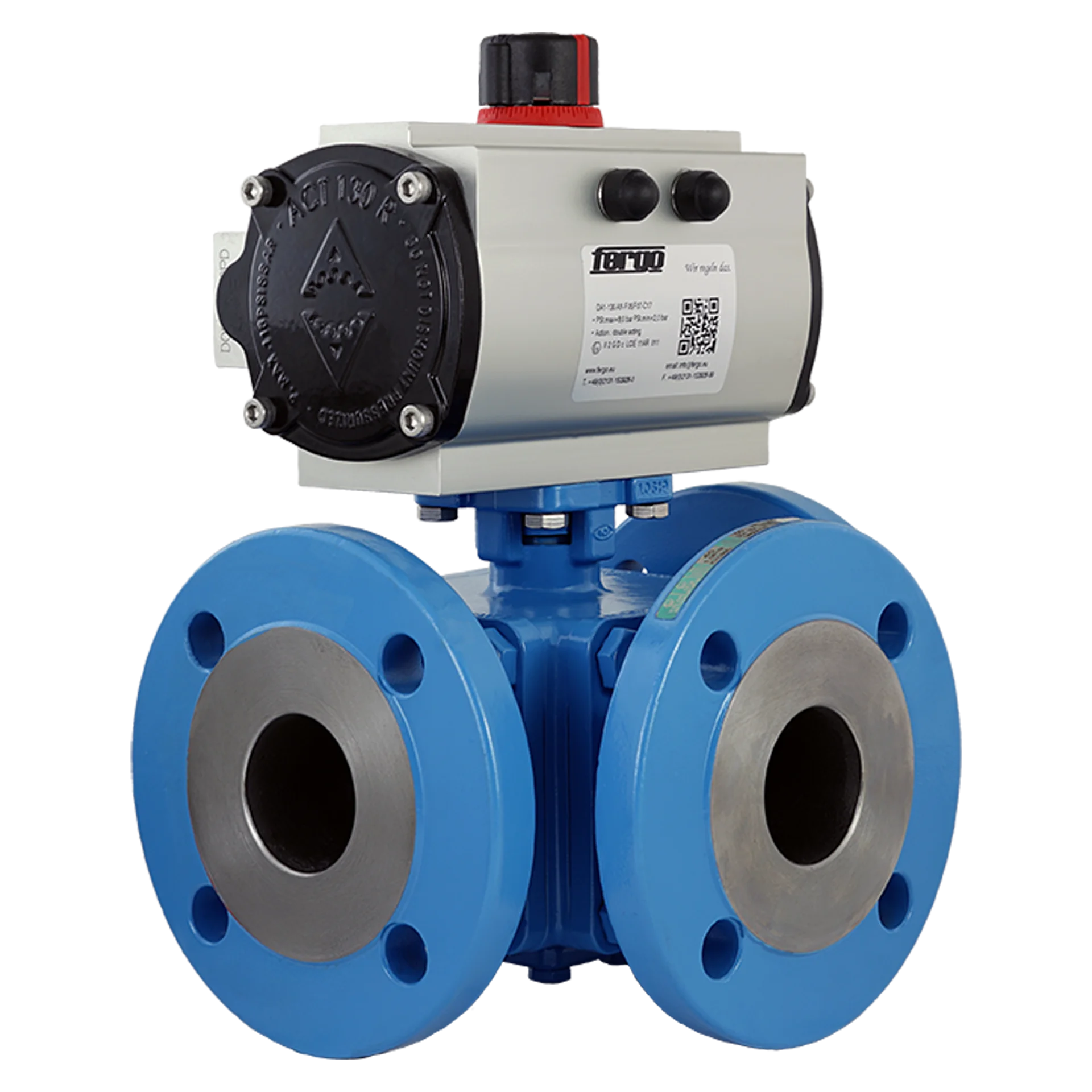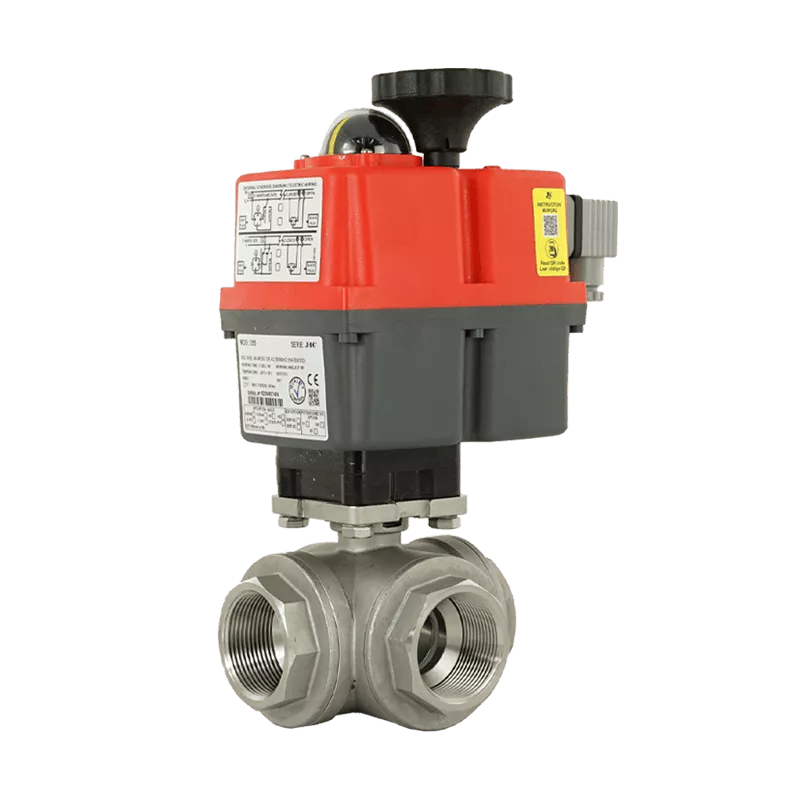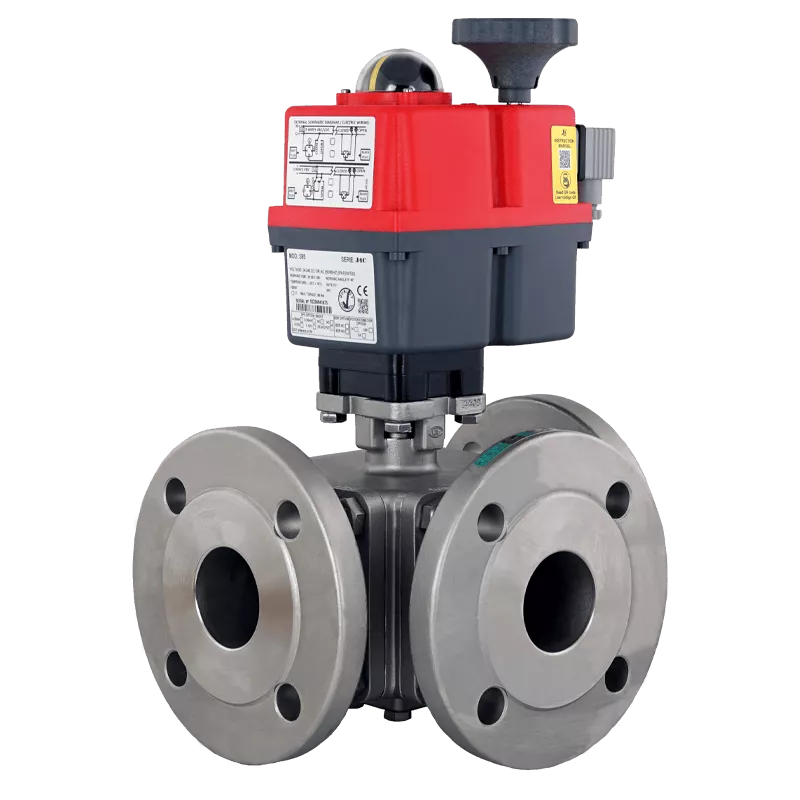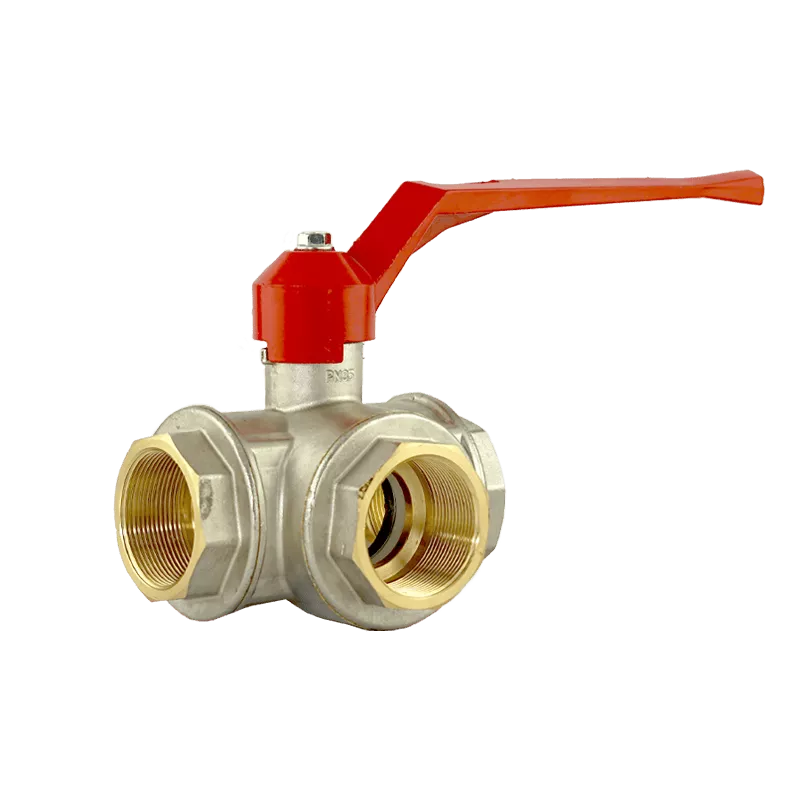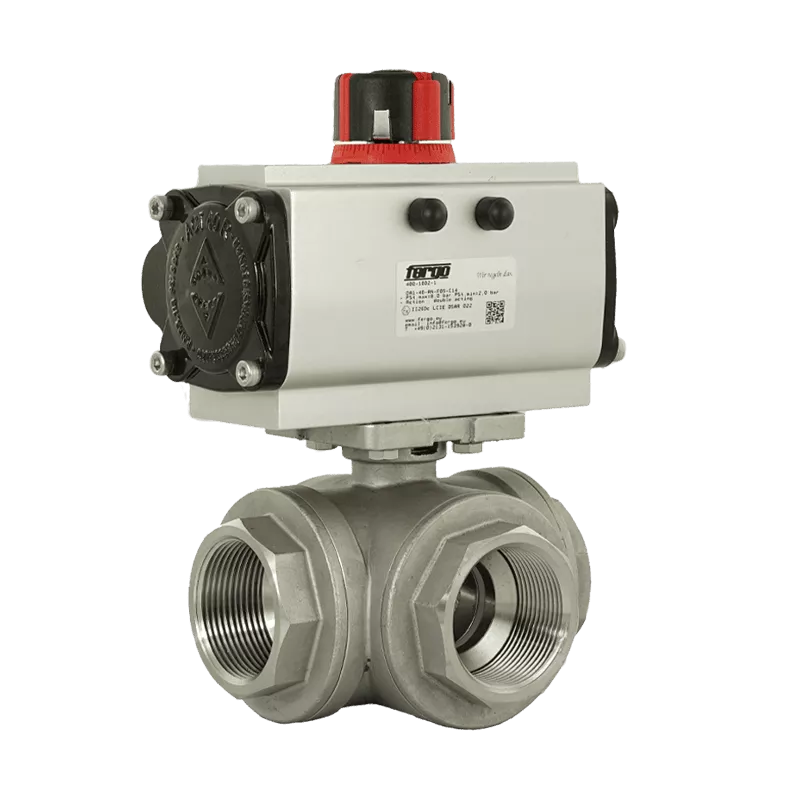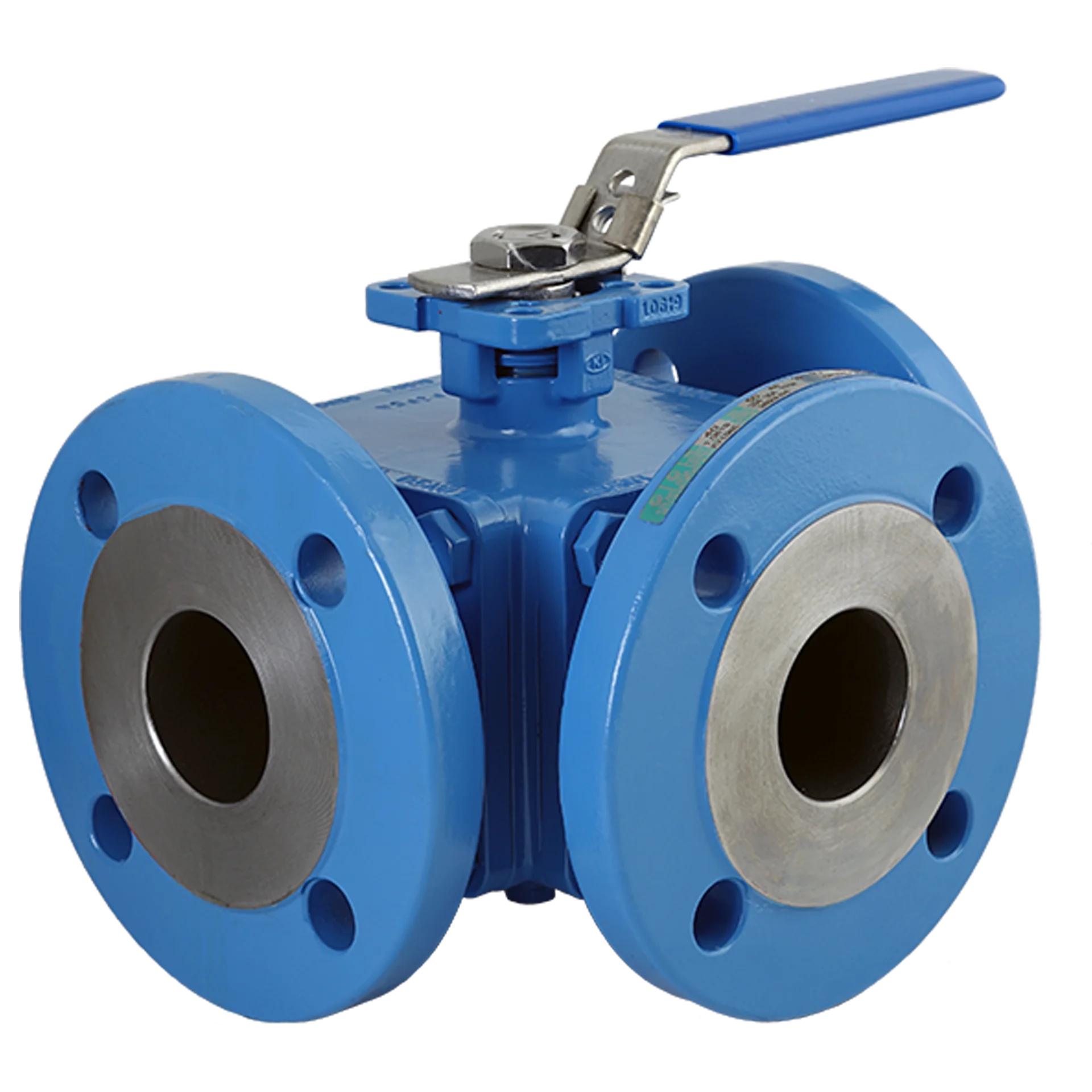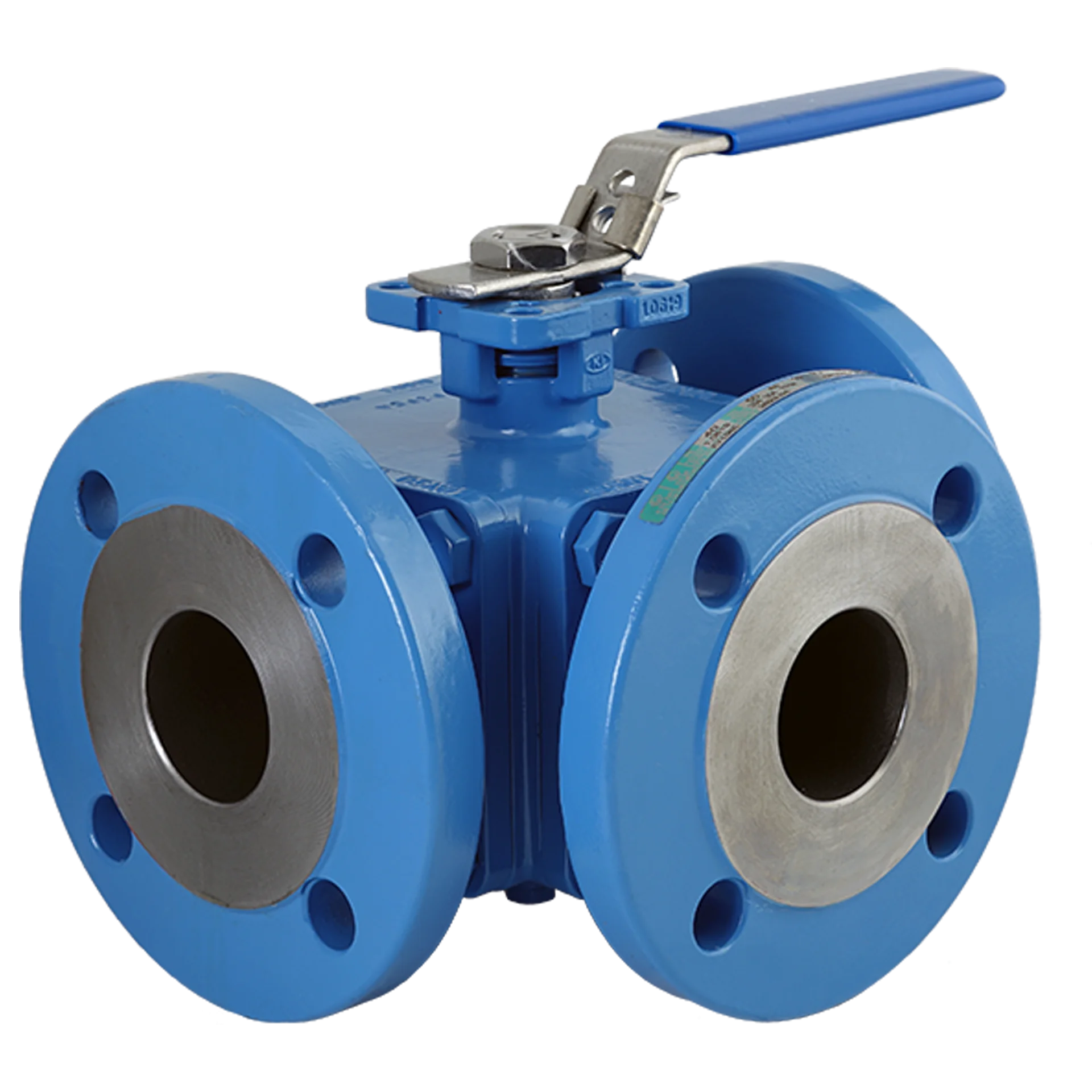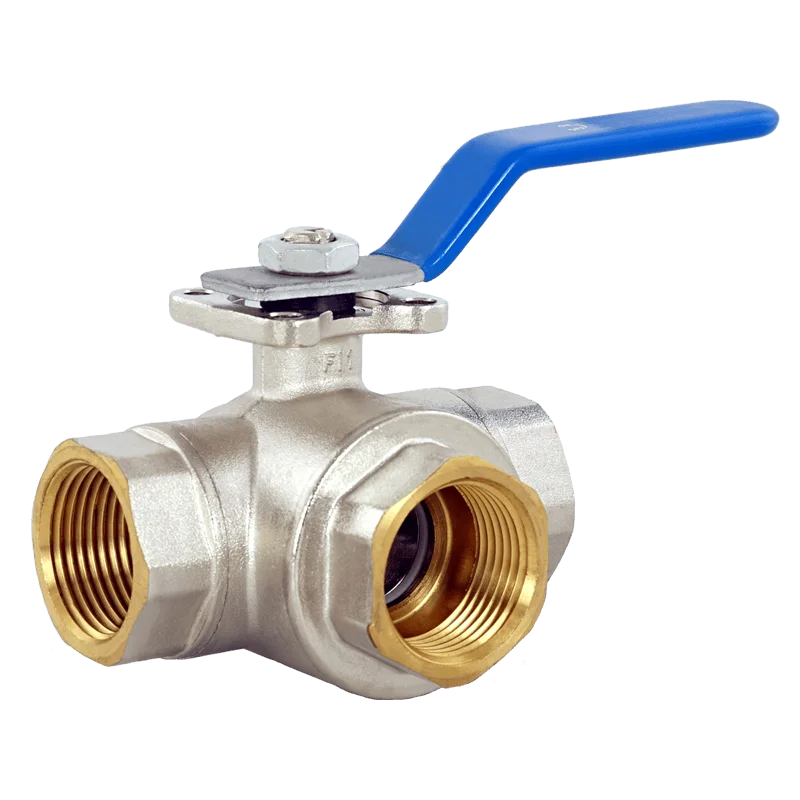
3-Way Ball Valve L- And T-Bore
mixing, distributing & diverting flow
Our large selection of 3-way ball valves made of stainless steel, steel (WCB) and brass enables the simple control of many industrial liquids and gases. The multi-port ball valves with flanged and threaded connections adapt easily to your pipework. The 3-way ball valves are available in L and T bores.
3-Way ball Valve Electric
Thanks to the ISO 5211 top flange, the 3-way ball valves can be easily automated with an electric actuator. The electric ball valve is available with a flexible voltage range of 24V - 230V - 240V AC/DC.
3-Way Ball Valve Pneumatic
Thanks to the ISO 5211 top flange, the 3-way ball valves can be easily automated with a pneumatic actuator. Pneumatic ball valve available in double-acting or single-acting (Normally closed/Normally open) versions.
Ball valves with limit switches - solenoid valves & more!
Fergo offers fully assembled ball valves with pneumatic or electric actuators with additional accessories such as solenoid valves, mounting bridges, adapters and surface-mounted fittings such as position indicators, position indicators, limit switches and positioners.
Fergo offers a wide range of pneumatic actuators, depending on torque, design, connection, ISO 5211 flange. Here are the available options:
Sub-Categories
KL103 3-way ball valve 1 inch stainless steel L bore single acting pneumatic actuator Product number: 101-1002-06-SR
3-way ball valve 1 inch pneumatic actuatorL-bore design, reduced bore, internal thread acc. to ISO 7-1 (EN 10226-1), body & ball made of 1.4408, gasket made of PTFE + 15% GF, Operating temperature -25°C to +180°C, Max. Operating pressure: 63 bar, Actuation Pneumatic single-acting actuator (Normally closed).
Nominal width :
DN25 - 1'' inch
DN25 - 1'' inch
Actuation :
Pneumatic Actuator
Pneumatic Actuator
Design :
3 ways
3 ways
Body:
Stainless Steel (1.4408)
Stainless Steel (1.4408)
Bore:
L
L
Available, delivery time: in stock
KT103 3-way ball valve 3/4 inch stainless steel T bore Product number: 102-1002-05
3-way ball valve 3/4 inch stainless steel T bore T bore design, reduced bore, internal thread acc. to ISO 7-1 (EN 10226-1), body & ball made of 1.4408 stainless steel, blow-out proof stem and antistatic device, seal made of PTFE + 15% GF, Operating temperature -25°C to +180°C, Max. Operating pressure: 63 bar, Hand lever.
Nominal width :
DN20 - 3/4'' inch
DN20 - 3/4'' inch
Design :
3 ways
3 ways
Actuation :
Hand Lever
Hand Lever
Body:
Stainless Steel (1.4408)
Stainless Steel (1.4408)
Bore:
T
T
Available, delivery time: in stock
KL112 3-way flanged ball valve DN 20 PN16/40 stainless steel L Bore pneumatic single-acting actuator Product number: 101-1008-05-SR
Three-way ball valve DN 20 PN16/40 with pneumatic single-acting actuator Design 3-way L Bore, full port, flanged ends acc. to DIN PN16/40, body & ball 1.4408 stainless steel, ball seal TFM 1600, temp. (min./max.) -29°C to +175°C, max. operating pressure 40 bar, TA Luft, ATEX, SIL with pneumatic single-acting actuator (Normally Closed)
Actuation :
Pneumatic Actuator
Pneumatic Actuator
Body:
Stainless Steel (1.4408)
Stainless Steel (1.4408)
Design :
3 ways
3 ways
Nominal width :
DN20 - 3/4'' inch
DN20 - 3/4'' inch
Bore:
L
L
Available, delivery time: in stock
KL112 3-way flanged ball valve DN 40 PN16/40 steel L bore pneumatic double-acting actuator Product number: 102-1009-08-DA
3-way flanged ball valve DN 40 with pneumatic actuatorL-bore full bore, flange connection to DIN PN16/40, body made of cast steel 1.0619 WCB, ball made of 1.4308 (SS304) stainless steel, seal TFM 1600, temp. (min./max.) -29°C to +175°C, max. operating pressure 40 bar, TA Luft design, ATEX, with pneumatic quarter-turn actuator double-acting. Max. operating pressure 40 bar, TA Luft design, ATEX, with double-acting pneumatic quarter-turn actuator
Actuation :
Pneumatic Actuator
Pneumatic Actuator
Body:
Steel (1.0619)
Steel (1.0619)
Nominal width :
DN40 - 1 1/2'' inch
DN40 - 1 1/2'' inch
Design :
3 ways
3 ways
Bore:
T
T
Available, delivery time: in stock
KL112 3-way flanged ball valve DN 40 PN16/40 steel L bore pneumatic double-acting actuator Product number: 101-1009-08-DA
3-way flanged ball valve DN 40 with pneumatic actuatorL-bore full bore, flange connection to DIN PN16/40, body made of cast steel 1.0619 WCB, ball made of 1.4308 (SS304) stainless steel, seal TFM 1600, temp. (min./max.) -29°C to +175°C, max. operating pressure 40 bar, TA Luft design, ATEX, with pneumatic quarter-turn actuator double-acting. Max. operating pressure 40 bar, TA Luft design, ATEX, with double-acting pneumatic quarter-turn actuator
Actuation :
Pneumatic Actuator
Pneumatic Actuator
Design :
3 ways
3 ways
Nominal width :
DN40 - 1 1/2'' inch
DN40 - 1 1/2'' inch
Body:
Steel (1.0619)
Steel (1.0619)
Bore:
L
L
Available, delivery time: in stock
KL103 3-way ball valve 2 1/2 inch stainless steel L hole electric actuator 24V - 230V - 240V Product number: 101-1002-10-EL
3-way ball valve 2 1/2 inch electricL-bore design, reduced bore, internal thread acc. to ISO 7-1 (EN 10226-1), body & ball made of stainless steel (1.4408), seal made of PTFE + 15% GF, Operating temperature -25°C to +180°C, Max. operating pressure: 63 bar, Actuation: electric (J4C S85). Operating pressure: 63 bar, Actuation: electrical (J4C S85), Running time(90°) 29s ± 10%, 24V - 230V - 240V AC/DC 50/60HZ
Bore:
L
L
Actuation :
Electric Actuator
Electric Actuator
Nominal width :
DN65 - 2 1/2'' inch
DN65 - 2 1/2'' inch
Design :
3 ways
3 ways
Body:
Stainless Steel (1.4408)
Stainless Steel (1.4408)
Available, delivery time: in stock
KT112 3-way flanged ball valve DN 50 PN16/40 stainless steel T-bore electric actuator 24V - 230V - 240V Product number: 102-1008-09-EL
Electric 3 way ball valve DN 50 PN16/40 T bore, full bore, flange connection acc. to DIN PN16/40, body & ball made of 1.4408 stainless steel, gasket TFM 1600, temp. (min./max.) -29°C to +175°C, max. Operating pressure 40 bar, TA Luft design, ATEX with Electric actuator 24V - 230V - 240V AC/DC
Nominal width :
DN50 - 2'' inch
DN50 - 2'' inch
Actuation :
Electric Actuator
Electric Actuator
Design :
3 ways
3 ways
Body:
Stainless Steel (1.4408)
Stainless Steel (1.4408)
Bore:
T
T
Available, delivery time: in stock
KL100 3-way ball valve 1/2 inch brass L bore Product number: 101-1000-04
Brass 3-way ball valve 1/2 inch, type L bore, female thread acc. to ISO 228 F-F-F, body made of brass, nickel-plated, ball made of brass, hard-chrome plated, seal made of PTFE, seal shaft: Viton, medium temp. (min./max.): -10°C to +120°C Not suitable for steam, Max. operating pressure: 50 bar, Manual lever operation
Bore:
L
L
Body:
Brass
Brass
Nominal width :
DN15 - 1/2'' inch
DN15 - 1/2'' inch
Design :
3 ways
3 ways
Actuation :
Hand Lever
Hand Lever
Available, delivery time: in stock
KL103 3-way ball valve 2 1/2 inch stainless steel L bore double acting pneumatic actuator Product number: 101-1002-10-DA
3-way ball valve 2 1/2 inch pneumaticL-bore design, reduced bore, female thread acc. to ISO 7-1 (EN 10226-1), body & ball made of 1.4408, seal ball: PTFE + 15% GF, Operating temperature -25°C to +180°C, Max. operating pressure: 63 bar, Actuation double-acting pneumatic actuator
Design :
3 ways
3 ways
Body:
Stainless Steel (1.4408)
Stainless Steel (1.4408)
Bore:
L
L
Actuation :
Pneumatic Actuator
Pneumatic Actuator
Nominal width :
DN65 - 2 1/2'' inch
DN65 - 2 1/2'' inch
Available, delivery time: in stock
KL112 3-way flanged ball valve DN 40 PN16/40 stainless steel L Bore pneumatic single-acting actuator Product number: 101-1008-08-SR
Three-way ball valve DN 40 PN16/40 with pneumatic single-acting actuator Design 3-way L Bore, full port, flanged ends acc. to DIN PN16/40, body & ball 1.4408 stainless steel, ball seal TFM 1600, temp. (min./max.) -29°C to +175°C, max. operating pressure 40 bar, TA Luft, ATEX, SIL with pneumatic single-acting actuator (Normally Closed)
Bore:
L
L
Actuation :
Pneumatic Actuator
Pneumatic Actuator
Nominal width :
DN40 - 1 1/2'' inch
DN40 - 1 1/2'' inch
Design :
3 ways
3 ways
Body:
Stainless Steel (1.4408)
Stainless Steel (1.4408)
Available, delivery time: in stock
KL112 3-way flanged ball valve DN 100 PN10/16 steel L bore Product number: 101-1009-12
3-way flanged ball valve DN 100 PN16 made of cast steelL-bore full bore, flanged connection to DIN PN16/40, body made of cast steel 1.0619, ball made of 1.4308 (SS304) stainless steel, seal TFM 1600, temp. (min./max.) -29°C to +175°C, max. Operating pressure 40 bar, TA Luft design, ATEX, Actuation: Hand lever with locking tab
Design :
3 ways
3 ways
Actuation :
Hand Lever
Hand Lever
Body:
Steel (1.0619)
Steel (1.0619)
Nominal width :
DN100 - 4'' inch
DN100 - 4'' inch
Bore:
L
L
Available, delivery time: in stock
KL112 3-way flanged ball valve DN 15 PN16/40 steel L bore pneumatic double-acting actuator Product number: 102-1009-04-DA
3-way flanged ball valve DN 15 with pneumatic actuatorL-bore full bore, flanged connection to DIN PN16/40, body made of cast steel 1.0619 WCB, ball made of 1.4308 (SS304) stainless steel, seal TFM 1600, temp. (min./max.) -29°C to +175°C, max. operating pressure 40 bar, TA Luft design, ATEX, with pneumatic quarter-turn actuator double-acting. Max. operating pressure 40 bar, TA Luft design, ATEX, with double-acting pneumatic quarter-turn actuator
Nominal width :
DN15 - 1/2'' inch
DN15 - 1/2'' inch
Actuation :
Pneumatic Actuator
Pneumatic Actuator
Body:
Steel (1.0619)
Steel (1.0619)
Design :
3 ways
3 ways
Bore:
T
T
Available, delivery time: in stock
KL103 3-way ball valve 1 1/2 inch stainless steel L bore electric actuator 24V - 230V - 240V Product number: 101-1002-08-EL
3-way ball valve 1 1/2 inch electricType L-bore, reduced bore, internal thread acc. to ISO 7-1 (EN 10226-1), body & ball made of 1.4408, seal made of PTFE + 15% GF, Operating temperature -25°C to +180°C, Max. operating pressure: 63 bar, Actuation: electrical (J4C S55), Running time(90°) 13s ± 10%, 24V - 230V - 240V AC/DC 50/60HZ
Actuation :
Electric Actuator
Electric Actuator
Body:
Stainless Steel (1.4408)
Stainless Steel (1.4408)
Design :
3 ways
3 ways
Bore:
L
L
Nominal width :
DN40 - 1 1/2'' inch
DN40 - 1 1/2'' inch
Available, delivery time: in stock
KT112 3-way flanged ball valve DN 50 PN16/40 steel T bore Product number: 102-1009-08
3-way flanged ball valve DN 50 PN16/40 made of cast steelT-bore full bore, flanged connection to DIN PN16/40, body made of cast steel 1.0619, ball made of 1.4308 (SS304) stainless steel, seal TFM 1600, temp. (min./max.) -29°C to +175°C, max. Operating pressure 40 bar, TA Luft design, ATEX, Actuation: Hand lever with locking tab
Nominal width :
DN50 - 2'' inch
DN50 - 2'' inch
Body:
Steel (1.0619)
Steel (1.0619)
Design :
3 ways
3 ways
Actuation :
Hand Lever
Hand Lever
Bore:
T
T
Available, delivery time: in stock
KL112 3-way flanged ball valve DN 80 PN16 steel L bore pneumatic double-acting actuator Product number: 101-1009-11-DA
3-way flanged ball valve DN 80 with pneumatic actuatorL-bore full bore, flanged connection to DIN PN16, body made of cast steel 1.0619 WCB, ball made of 1.4308 (SS304) stainless steel, seal TFM 1600, temp. (min./max.) -29°C to +175°C, max. operating pressure 16 bar, TA Luft design, ATEX, with pneumatic quarter-turn actuator double-acting. Max. operating pressure 16 bar, TA Luft design, ATEX, with double-acting pneumatic quarter-turn actuator
Actuation :
Pneumatic Actuator
Pneumatic Actuator
Design :
3 ways
3 ways
Nominal width :
DN80 3'' inch
DN80 3'' inch
Body:
Steel (1.0619)
Steel (1.0619)
Bore:
L
L
Available, delivery time: in stock
KL113 3-way ball valve 1/2 inch brass L bore Product number: 101-1001-04
3-way ball valve 1/2 inch made of brass Type L bore, internal thread (BSP) acc. to ISO 228-1 F-F-F, body made of brass, nickel plated, ball made of brass, chrome plated, seal ball PTFE, stem seal PTFE, medium temp. (min./max.) -20°C to +150°C, max. operating pressure: 25 bar, operation hand lever
Bore:
L
L
Body:
Brass
Brass
Nominal width :
DN15 - 1/2'' inch
DN15 - 1/2'' inch
Design :
3 ways
3 ways
Actuation :
Hand Lever
Hand Lever
Available, delivery time: in stock
High-quality 3-way ball valves in many designs!
3-way ball valve: Socket and flange connection
Our three-way ball valves are available with threaded connections in nominal sizes of 1/4", 3/8", 1/2", 3/4", 1", 1 ¼", 1 ½" and 2" inch or with flanged connections in nominal sizes from DN15 to DN100 PN10/16/25/40. They can be manufactured with full or reduced flow, depending on your specific requirements. We offer both threaded ball valves and 3-way ball valves with flanged connections with electric and pneumatic actuators.
How does a three-way valve work?
Three-way valves are designed to combine two different input flows before outputting them as separate flows. They are typically used in modulating control systems, but can also be used in on/off applications. These valves are also available in diverting and mixing configurations. Distribution valves have one supply connection and two outputs, but are generally more expensive than mixing valves.
A three-way valve is used to control the flow of different liquids and also allows different mixing ratios. It is ideal for diverting the flow from one destination to another by blocking one outlet and diverting the flow to another. If you are looking for a valve with a wide range of applications, you should consider a three-way ball valve. The operation of a three-way valve depends on the design of the mechanism. In general, these valves can connect three orthogonally arranged pipes whose T-pattern crosses or merges the third channel. In contrast to horizontal valves, vertical T-ball valves have a common port that is always open. The bottom port is normally open, and turning the handle 90 degrees interrupts the flow.A three-way valve has two ports that are normally open to allow flow from one port, while the third port is closed to stop the flow. The three-way ball valve with L-shaped flow is designed to rotate anti-clockwise. This rotates the ball 180 degrees, blocking the flow from the left side and directing it to the right. A further anti-clockwise rotation closes the valve. As soon as the ball has moved back to the centre, the valve is open and the flow can continue on its way.
3-Way-Ball-Valve L Bore Position
A 3-way ball valve with an L-bore is a valve that can be used to control the flow of a medium in a system via three different positions. The term L-bore refers to the shape of the passage opening in the ball, which is L-shaped. The three switching positions of the valve enable a straight flow, a branching flow and a completely closed flow path. By turning the ball in the centre of the valve, it is possible to switch between these positions and adjust the flow of the medium as required.
The following illustration shows some of the L-bores. If the design example does not meet your requirements, please write to us with your desired design. We assure you that we will fulfil your requirements.

3-Way-Ball Valve T Bore Position
A 3-way ball valve with a T-bore enables three switching positions: straight flow, branching flow and closed flow. The T-bore refers to the shape of the passage opening in the ball, which is T-shaped. By turning the ball in the centre of the valve, these switching positions can be selected to control the flow of the medium.
The following illustration shows some examples of L-shaped openings. If the design example does not meet your requirements, please contact us and let us know your desired design. We are sure that we can also fulfil your requirements.



